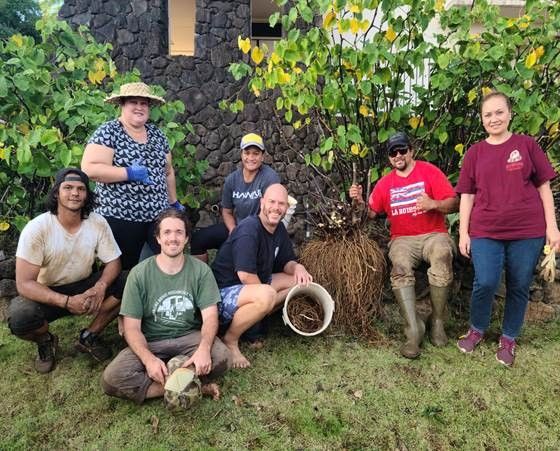In this Kūkahekahe column we celebrate the Kealaikahiki Voyage of the voyaging canoes Hōkūleʻa and Hikianalia to French Polynesia by sharing about Kamehameha Schools’ special gift of homegrown ʻawa.
The Kealaikahiki Voyage honors the ancient sea road between Hawaiʻi and our ancestral homeland, Kahiki (which includes Tahiti and closely affiliated archipelagos within French Polynesia). When crew members of Hōkūleʻa and Hikianalia and our own KS delegation of recent graduates, cultural specialists, and K-12 administrators participate in ceremonies in French Polynesia in a few weeks, they will be gifting ʻawa that was planted as a symbol of partnership more than two years ago in the Waineʻemālie māla at Kaʻiwakīloumoku on our Kapālama campus. It is believed that this is the first time Kamehameha Schools has been able to provide homegrown ʻawa that has been planted, harvested, and processed for our ceremonial use.
In 2019, the Kaʻiwakīloumoku Hawaiian Culture Center hosted the Honorable Heremoana Maamaatuaiahutapu, minister of Culture and the Environment for French Polynesia (FP) who participated in the ceremonial planting of ʻawa alongside ʻAha Moananuiākea Pacific Consortium partner representatives KS CEO Jack Wong, Polynesian Voyaging Society President Nainoa Thompson (PVS), and University of Hawai‘i President David Lassner.
Also planting ʻawa hiwa on that occasion were KSK Poʻo Kula Taran Chun KSK’95, Director of Teaching and Learning Innovations Shawna Medeiros, as well as Kapalama campus principals Wendy Erskine (KHS), Kula Gaughen-Haili (KMS), and Deede Santiago KSK’82 (KES). ʻAwa, also known as kava in other parts of the Pacific, is a medicinal plant that was made into a beverage that can be consumed both for ceremony and recreation. Some refer to ʻawa as a “canoe plant,” as it was intentionally carried by our ancestors on voyages across Moananuiākea during the peopling of the Pacific over thousands of years.
After some two and a half years, staff members harvested a single pū ʻawa hiwa, a sacred black variety of ʻawa that was traditionally reserved for aliʻi and used in significant ceremonies. This particular variety of ʻawa was obtained at Hui Kū Maoli Ola in Kāneʻohe, Oʻahu. The ʻawa grown on campus will be a gift for French Polynesian President Édouard Fritch and the elders and tahuʻa (kahuna) of Marae Taputapuātea, which is among the most sacred religious sites in East Polynesia and a revered voyaging mecca for chiefs and navigators. It is also a UNESCO World Heritage Site.
“We have built these relationships with our Tahitian family over the past thirty-five years and now with formal signed declarations with the government and cultural leaders in Tahiti, learning opportunities for our haumāna, kumu and ʻohana are richer and much more deep,” said Kaʻiwakīloumoku Manager Jamie Fong.
With the guidance and expertise of Kanoa O’Connor and Kumuhonua Wong of Hoʻoulu ʻĀina, Hoʻokahua staff and ʻawa enthusiast Community Strategies Project Manager Keoni Shizuma undertook the challenging task of digging and unearthing the enormous ʻawa root ball, which was estimated at close to 40 pounds.
The following day, O’Connor and Wong were joined by Puni Jackson, Casey Jackson, Scotty Garlough, Joey Miller, Casey Chikuma, Fiore Anderson and other generous caretakers at Hoʻoulu ʻĀina in Kalihi Uka to clean, dry and dehydrate the ʻawa into powder. This labor-intensive effort took many hands over the course of four days and was spearheaded by Kahu ʻAwa and KS Cultural Specialist Lāiana Kanoa-Wong.
It was a new experience harvesting and processing ʻawa for many staff. Kanoa-Wong shared, “This is the first time I’ve been able to be a part of the entire process surrounding the preparation of ʻawa. The fact that everyone has been able to put their mana into this gift that we are carrying to Taputapuātea is amazing.”

The ʻawa harvest team spent two hours digging up an ʻawa hiwa plant which had been growing for more than two and a half years. They included: Kumuhonua Wong (Hoʻoulu ʻĀina), Hoʻokahua Senior Administrative Assistant Hiwalani Chang, Kanoa OʻConnor (Hoʻoulu ʻĀina), KS Cultural Specialist Kēhau Peʻa, Cultural Specialist Kāwika McGuire, Cultural Specialist Lāiana Kanoa-Wong, and Ka‘iwakīloumoku Cultural Center Manager Jamie Fong KSK’78.

KS CEO Jack Wong, Minister for Culture and Environment of French Polynesia Heremoana Maamaatuaiahutapu and Polynesian Voyaging Society President Nainoa Thompson plant an ʻawa hiwa in 2019 at Waineʻemālie Garden below Ka‘iwakīloumoku.

From left, Kamehameha Schools Kapālama campus Principals Deedee Santiago (KES), Wendy Erskine (KHS), Director of Teaching and Learning Innovations Shawna Medeiros, Principal Kula Gaughen-Haili (KMS) and Poʻo Kula Taran Chun plant an ʻawa together.

ʻAha Moananuiākea partners during the visit of the French Polynesian delegation in 2019 following the planting of ʻawa hiwa.

Caretakers from Hoʻoulu ʻĀina and KS staff help clean and chop the ʻawa roots before grinding and drying.

ʻAwa roots are ground and pressed onto drying mats to be dried for a few days before powdering and packaging.

The finished ʻawa packaged and ready for gifting with a portrait of elder Alban Ellacott, who founded the group Tainui Friends of Hōkūleʻa in Tahiti prior to the 1976 voyage.

The packaged ʻawa includes a special label commemorating the Kealaikahiki voyage.
TAGS
kūkahekahe,
hōkūleʻa,
hikianalia,
kealaikahiki voyage
CATEGORIES
Kaipuolono Article, Regions, Hawaii Newsroom, KS Hawaii Home, Kapalama Newsroom, Kapalama Home, Maui Newsroom, KS Maui Home, Newsroom, Campus Programs, Hawaii, Kapalama, Maui, Department News, Ho‘okahua, Hawaii campus, Kapalama campus, Maui campus
Print with photos
Print text only










